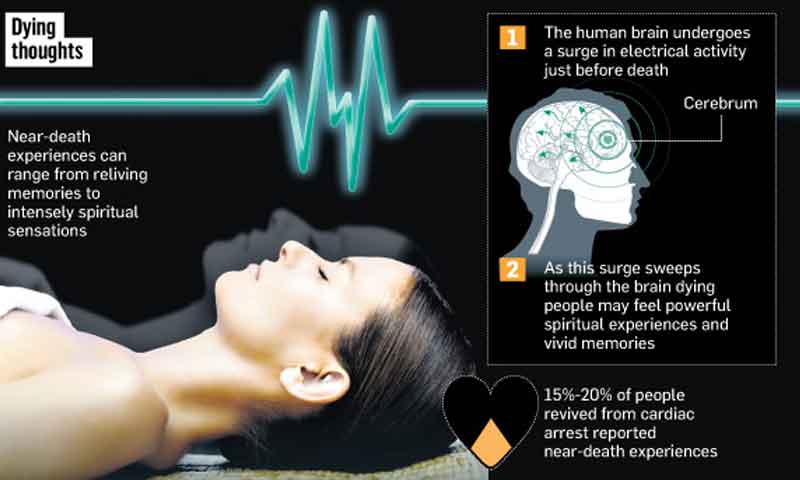
Researchers say the findings could help explain the vivid near-death experiences (bright lights, hallucinations) reported by people who were close to death, Medical News Today reported.
What happens to our consciousness when we die?

It’s perhaps the biggest question — and source of angst — when it comes to the human condition.
Those who report near-death experiences can offer a tantalizing glimpse of what our final moments feel and look like. Many of these experiences are strikingly similar, with people reporting vivid experiences that include visions of deceased loved ones, bright lights, and the feeling of floating through the air.
While near-death experiences are often viewed through a religious or philosophical lens, researchers from the University of Michigan have studied the phenomenon on a scientific level, finding a spike in brain activity at the time of death.
Their findings were published this week in the Proceedings of the National Academy of Science.

Jimo Borjigin, Ph.D., an associate professor in the Department of Molecular & Integrative Physiology and the Department of Neurology at the University of Michigan, led the study, which builds on earlier research that showed a neural surge in the dying brains of animal test subjects.
“We were postulating that [the surge] may represent neural correlates of consciousness that could potentially link the subjective experiences of people who survive cardiac arrest,” Prof. Borjigin told Medical News Today.
While the research has limitations, researchers say it’s a significant step forward in understanding the underlying reasons for vivid near-death experiences — and offers a glimpse at what our last moments may feel like.
Near-death experiences difficult to study

While it’s simple enough to conduct experiments on animals, it’s tough on both an ethical and practical level to study humans in the final stages of life.
Prof. Borjigin said that she and her colleagues wanted to do justice to the earlier data to see if the human brain responded to death in the same way observed in a rat brain.
To that end, the brain activity of four people who passed away in hospitals while being monitored by an EEG (electrogram) device was studied.
“The data generated, even though it’s only four patients, is massive, so we were able to only report a fraction of the features that it’s actually showing on the data,” Prof. Borjigin said.
At the time of death, brain activity was detected in the TPJ region of the brain — named because it’s the junction between the temporal, parietal and occipital lobes in the back of the brain.
The TPJ already has a known association with dreaming, hallucinations, and altered states of consciousness.
“I really wanted to be able to define something in the brain that can potentially explain that subjective near-death experience,” Prof. Borjigin said. “Some of these patients might have if they had survived to tell their stories, but unfortunately they didn’t.”
Covert consciousness
While it’s impossible to know what the patients experienced during these brain surges, this increased activity in the TPJ could help explain vivid near-death experiences.
Even though the patients weren’t visibly conscious, the uptick in brain activity showed covert consciousness — in other words, consciousness that can’t be detected using bedside exams because the patient is incapacitated.
“[People who’ve had near-death experiences] may remember seeing or hearing things, or having an out-of-body experience or motion perception as if they’re flying,” Prof. Borjigin explained. “I think that we have potentially at least defined or discovered minimum anatomical steps to neurosignatures of covert consciousness. We’d like to be able to study human subjects under less devastating circumstances, where the patients are known to be able to survive and then tell the story where they can correlate their brain signature with a subjective experience.”
In order to make this correlation, patients who survive cardiac arrest while being monitored by an EEG device could be interviewed to see if their brain waves line up with their experience.
A bioethicist reacts to the study
“What this study really suggests is that the brain is undergoing some chemical changes during the dying process. It explains the perceptions people have about seeing angels or light at the end of a tunnel,” Arthur Caplan, a bioethicist at NYU Langone Medical Center in New York, told Healthline. “What it shows is that the brain has measures that it takes to try and wake itself up and fires off in ways that can be hallucinatory.”
Many people are curious about what happens next after death, but this study is very preliminary and doesn’t go down that road, he said.
“In some ways, this study sheds light on people’s fear that maybe they’re going to suffer when they’re dying at the last moment and that doesn’t seem to be the case. But maybe they’ll be disappointed because what this study is suggesting is you don’t get any insights from the dying experience into what really comes next,” Caplan added.




